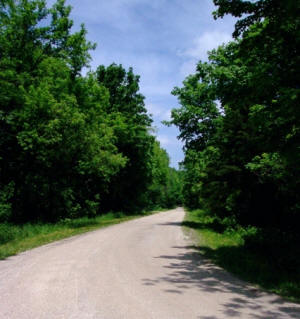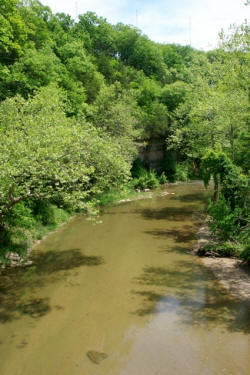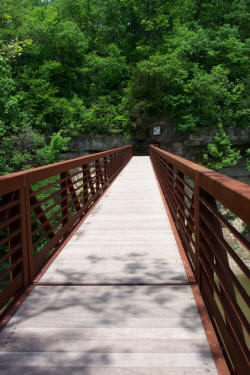Although many IOU members have spent time birding in southeastern Iowa, spots such as Lacey-Keosauqua State Park (Van Buren County), Shimek State Forest/Croton Unit (Lee County), and Cone Marsh (Louisa County) have often been the objects of their birding desire.
Starr’s Cave Park and Preserve (Figure 1) is a lesser known, but very productive, birding hotspot in the southeastern corner of the state. Established in the mid-1970s, it is owned by the state and managed by the Des Moines County Conservation Board. The preserve is a 200-acre area just north of Burlington. Features include an extensive trail system through mature woodlands, prairie remnants, and the limestone bluffs along Flint Creek. Three caves are also located within the preserve. The limestone bluffs in which the caves are located are a favorite place among geologists. The rock is composed mainly of crinoid fossils, a sea animal from the Mississippian Period 300 million years ago. The bluffs are also the home of the internationally known Starr’s Cave Rock Formation, a unique oolite limestone first discovered here.
 Figure 1. Starr’s Cave State Preserve birding areas: (1) Starr’s Cave Road, (2) small open meadow, (3) Nature Center building and parking lot, (4) prairie trail, (5) two trails through woods, (6) observation stand, (7) paved walkway along Flint Creek, (8) pedestrian bridge over Flint Creek.
Figure 1. Starr’s Cave State Preserve birding areas: (1) Starr’s Cave Road, (2) small open meadow, (3) Nature Center building and parking lot, (4) prairie trail, (5) two trails through woods, (6) observation stand, (7) paved walkway along Flint Creek, (8) pedestrian bridge over Flint Creek.
 The park has a nature center staffed by two naturalists. They offer diverse programming for schools, scouts, and other special interest groups. In the summer, youths can enroll in a variety of day camps. Starr’s Cave staffers greet birders warmly and often stop to ask what is being seen.
The park has a nature center staffed by two naturalists. They offer diverse programming for schools, scouts, and other special interest groups. In the summer, youths can enroll in a variety of day camps. Starr’s Cave staffers greet birders warmly and often stop to ask what is being seen.
Birders can reach Starr’s Cave Park and Preserve by turning east onto Sunnyside Avenue from U.S. Highway 61 at the north edge of Burlington (Figure 1). Proceed on Sunnyside Avenue for one-half mile and turn north (left) onto Irish Ridge Road. Follow this road past several subdivisions and down the hill to the entrance road into the park.
The entrance road, Starr’s Cave Road (Figures 1.1 and 2), while technically not a part of the park, is an excellent location for spotting migrating and nesting passerines. Most of the reports of birds seen at Starr’s Cave are from this entrance road. Red-eyed and Yellow-throated Vireos nest along the road; Blue-headed, Philadelphia, and occasional White-eyed Vireos are found here during migration. Warbler species seen along the entrance road include three common nesters: American Redstart, Northern Parula, and Common Yellowthroat. Migrating warblers that are usual visitors in the spring and fall include Blackburnian, Canada, Blackpoll, Black-throated Green, Magnolia, Chestnut-sided, Bay-breasted, Blue-winged, Golden-winged, Nashville, Tennessee, Orange-crowned, Ovenbird, Mourning, Wilson’s, Black-and-white, and Connecticut. Warblers seen occasionally along the road include Yellow-breasted Chat, Cape May, Worm-eating, and Black-throated Blue. It is not uncommon to have warblers and vireos “dripping” from the trees along the entrance road in spring and fall if the weather conditions are right.
Flycatchers seen along the entrance road or in the park include migrating empids and Olive-sided Flycatcher, as well as nesting Eastern Wood Pewee, Eastern Phoebe, and Great Crested Flycatcher. Baltimore Oriole, Rose-breasted Grosbeak, Indigo Bunting, Blue-Gray Gnatcatcher, Yellow-billed Cuckoo, and Carolina Wren are regularly seen along the entrance road during nesting season as well. Pileated Woodpeckers, while not plentiful, can be found here at any time of the year. Wild Turkeys, which are plentiful, are seen regularly along the road.
Once inside the park, a good birding area is a small open meadow (Figure 1.2) along the right side of the road. This field, which is encircled by trees, features plants attractive to butterflies and is used by the naturalists as a wildflower study area. This is a good spot for Eastern Goldfinch, a number of sparrow species, Indigo Bunting, and wrens. A variety of raptors often perch in the trees at the back of this meadow, including all three accipiters and Red-tailed and Broad-winged Hawks.
Beyond the small meadow, trees reappear on both sides of the entrance road. This small treed meadow, which has lots of young saplings, can be excellent during migration for warblers and flycatchers. Both cuckoos have been seen in this area. A Western Tanager was found here several years ago and migrating Summer Tanagers have been seen in this area as well.
Another good birding spot is found at the end of the entrance road near the Nature Center building and its parking lot (Figure 1.3). The naturalists maintain a bird feeding station near the building; it can be good for a variety of woodland birds. Nesters here include Yellow-throated Warbler, Baltimore Oriole, Northern Parula, and an occasional Cerulean Warbler. Check the sycamore trees in the area carefully — the nesters love to sing from them. A picnic shelter just east of the Nature Center building provides an annual nesting site for Eastern Phoebe.
 A main feature of Starr’s Cave Park and Preserve is Flint Creek. It flows in an easterly direction through much of the park, and then turns south near the Nature Center on its way to the Mississippi River about a mile from the park’s boundary. As a typical Iowa creek, it can be waded across during dry periods and can be a raging torrent following spring rains. A variety of birds can be found along the creek during the nesting season, including Wood Ducks, Great Blue Herons, Belted Kingfishers, Barred and Great Horned Owls, and Louisiana Waterthrushes. Bald Eagles can occasionally be found along Flint Creek during the winter.
A main feature of Starr’s Cave Park and Preserve is Flint Creek. It flows in an easterly direction through much of the park, and then turns south near the Nature Center on its way to the Mississippi River about a mile from the park’s boundary. As a typical Iowa creek, it can be waded across during dry periods and can be a raging torrent following spring rains. A variety of birds can be found along the creek during the nesting season, including Wood Ducks, Great Blue Herons, Belted Kingfishers, Barred and Great Horned Owls, and Louisiana Waterthrushes. Bald Eagles can occasionally be found along Flint Creek during the winter.
Located off of the Nature Center parking lot is a sign marking a prairie trail (Figure 1.4), which is a recent addition to the park. The trail follows Flint Creek through an area of second growth woodlands and low scrubby bushes and is an excellent place to find migrating warblers in the spring, including Mourning, Wilson’s, Canada, and Connecticut.
From a signboard just west of the Nature Center, two trails (Figure 1.5) head uphill, taking interested hikers through mature woodlands. Along the way you may see a wide variety of woodland species. Wintering Northern Saw-Whet Owls have been found here in the cedar trees on several occasions. Following the trails west through the woodlands will bring you eventually to a prairie, which is at the westernmost reaches of the park. There is an observation stand (Figure 1.6) at this location. Interesting birds found here include a variety of sparrows, American Goldfinches, Northern Harriers, and Red-tailed Hawks.
 North of the Nature Center is a woodland meadow featuring a paved walkway (Figure 1.7) along Flint Creek. Winter Wrens can be found here in early spring. In summer, this area is good for Carolina Wren, Scarlet Tanager, Yellow-throated Warbler, Northern Parula, and Louisiana Waterthrush. A wide variety of migrating warblers are found here in spring and fall. Rough-winged Swallows nest in the limestone bluffs across the creek and Broad-winged Hawks roost in the surrounding trees during migration. This is a beautiful area in spring, as it is filled with dozens of flowering redbud trees.
North of the Nature Center is a woodland meadow featuring a paved walkway (Figure 1.7) along Flint Creek. Winter Wrens can be found here in early spring. In summer, this area is good for Carolina Wren, Scarlet Tanager, Yellow-throated Warbler, Northern Parula, and Louisiana Waterthrush. A wide variety of migrating warblers are found here in spring and fall. Rough-winged Swallows nest in the limestone bluffs across the creek and Broad-winged Hawks roost in the surrounding trees during migration. This is a beautiful area in spring, as it is filled with dozens of flowering redbud trees.
There are three caves in the park; a newly constructed pedestrian bridge (Figures 1.8 and 3) takes you high over the creek and to the entrance of Starr’s Cave, the park’s namesake. Follow the paved walkway north through the woodland meadow to get to this pedestrian bridge. The bridge is reached by following the sidewalk up the hill a short distance. From the bridge there are excellent views of Flint Creek both up- and downstream (Figure 4) and, at thirty feet above the creek, the bridge provides great viewing of surrounding trees.
Starr’s Cave Park and Preserve is relatively small; the entire trail system can be easily hiked in about a half day. Birders stroll along the entrance road looking for moving flocks of passerines; one can easily walk the half-mile from one end of the road to the other end in about 30 minutes, allowing for time to search the treetops for passerines.
The Park and Preserve are open 6 A.M. to 10:30 P.M. daily. The Nature Center hours are Monday through Friday 9–3, Sunday 1–4, and by appointment.
What was once a family farm along Flint Creek is now an engaging birding destination. When visiting southeastern Iowa next time, plan to stop in Burlington to visit one of Iowa’s little birding gems, Starr’s Cave Park and Preserve.